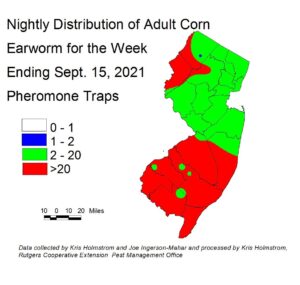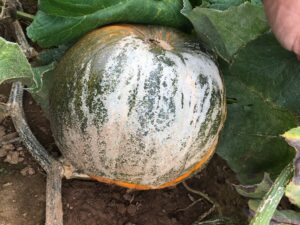Sweet Corn
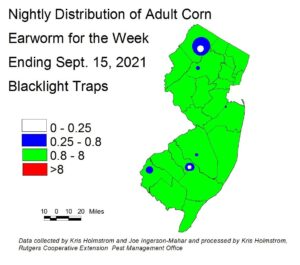 Corn earworm (CEW) moth captures from both trap types remain at high levels!!. Moth numbers have dropped across the state, but blacklight and pheromone traps still indicate the presence of a significant population. It is likely that CEW catches will rise and fall with evening temperatures for the next several weeks. Both trap types throughout the state are generally in agreement as to spray schedules (see below). Check this publication weekly for CEW status. The number of pheromone traps deployed is much lower, resulting in much broader color bands on the map. It is also important to understand that pheromone traps are more sensitive than blacklight traps, and thresholds are adjusted to account for the higher catches typical of this trap type. Silking corn is at extreme risk of CEW infestation at this time. On the blacklight map (left), green areas represent a 3-day silk spray schedule. Blue and white areas on the blacklight map should be considered outliers, and disregarded at this time. On the pheromone map (below right), red represents a 3 day spray schedule. Green areas on the pheromone map should be disregarded at this time, as this is largely due to gaps in data collection. Be sure to access information from this publication in the upcoming weeks to determine how frequently you should treat silking sweet corn to protect it from CEW infestation.
Corn earworm (CEW) moth captures from both trap types remain at high levels!!. Moth numbers have dropped across the state, but blacklight and pheromone traps still indicate the presence of a significant population. It is likely that CEW catches will rise and fall with evening temperatures for the next several weeks. Both trap types throughout the state are generally in agreement as to spray schedules (see below). Check this publication weekly for CEW status. The number of pheromone traps deployed is much lower, resulting in much broader color bands on the map. It is also important to understand that pheromone traps are more sensitive than blacklight traps, and thresholds are adjusted to account for the higher catches typical of this trap type. Silking corn is at extreme risk of CEW infestation at this time. On the blacklight map (left), green areas represent a 3-day silk spray schedule. Blue and white areas on the blacklight map should be considered outliers, and disregarded at this time. On the pheromone map (below right), red represents a 3 day spray schedule. Green areas on the pheromone map should be disregarded at this time, as this is largely due to gaps in data collection. Be sure to access information from this publication in the upcoming weeks to determine how frequently you should treat silking sweet corn to protect it from CEW infestation.
The highest nightly blacklight trap catches of CEW for the week ending 09/15/21 are as follows:
| Georgetown 9 | Princeton 5 | South Branch 4 |
| Bellemeade 8 | Eldora 4 | Allentown 3 |
| Crosswicks 5 | Hackettstown 4 | Farmingdale 3 |
| Matawan 5 | New Egypt 4 | Long Valley 3 |
The highest nightly pheromone trap catches of CEW for the week ending 09/15/21 are as follows:
| Woodstown 87 | Monroeville 59 | Elm 19 |
| Allamuchy 72 | Jones Island 49 | Snyder Farm (Hunterdon) 17 |
| Tabernacle 60 | Springdale 46 | Matawan 13 |
| Green Creek 59 | Crosswicks 19 | Beckett 12 |
Silking Spray Schedules*:
South – 3 days
Central – 3 days
North – 3 days
*These recommendations are based on regional catches. Adhere to tighter spray schedules if indicated by local trap catches. Synthetic pyrethroids alone should NOT be used for corn earworm (CEW) protection on silking corn, or for fall armyworm (FAW) management at any stage. Control with these materials is very inconsistent. Utilize materials in IRAC groups 5 and 28, or combination products that include IRAC group 28 for best control. See the Sweet Corn section of the 2020-21 Commercial Vegetable Production Guide for selections.
Cole Crops
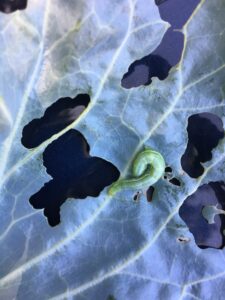 Fall plantings of cole crops are well underway at this time, and are frequently infested by imported cabbageworm (ICW) and diamondback moth (DBM) larvae. At this time, cabbage looper (CL-photo at left) and cross striped cabbage worm (CSCW-photo at right) are also causing
Fall plantings of cole crops are well underway at this time, and are frequently infested by imported cabbageworm (ICW) and diamondback moth (DBM) larvae. At this time, cabbage looper (CL-photo at left) and cross striped cabbage worm (CSCW-photo at right) are also causing injury to these crops, with CSCW becoming more common.
injury to these crops, with CSCW becoming more common.
Check 5 consecutive plants each in 10 random locations throughout the planting. Consider treating if caterpillars are found on 10% or more plants that are in the 0-9 true leaf stage. From 9-leaf to the early head stage (in broccoli, cauliflower, and cabbage) infestations up to 20% may be tolerated. Once heads begin to form, a 5% threshold should be observed to protect the marketable portion of the plant. For leafy greens such as collards and kale, 10% plants infested is the threshold throughout.
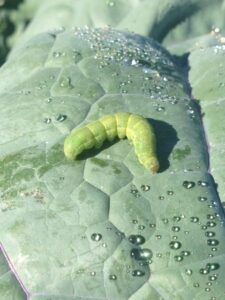 Some populations of DBM are resistant to carbamate and synthetic pyrethroid insecticides. The lack of DBM control with these insecticides has been noted in NJ previously. It is important to distinguish between common cole crop pests for this reason. DBM larvae grow to a length of approximately 0.5”, and taper toward both ends (see photo at right). These caterpillars thrash violently when disturbed. Newer chemistries that specifically target caterpillar pests are effective against DBM as well as all other caterpillar pests of cole crops, including beet armyworm (BAW-see photo at left), another species with exhibiting pyrethroid resistance. These materials include (active ingredient – trade name (IRAC* code)):
Some populations of DBM are resistant to carbamate and synthetic pyrethroid insecticides. The lack of DBM control with these insecticides has been noted in NJ previously. It is important to distinguish between common cole crop pests for this reason. DBM larvae grow to a length of approximately 0.5”, and taper toward both ends (see photo at right). These caterpillars thrash violently when disturbed. Newer chemistries that specifically target caterpillar pests are effective against DBM as well as all other caterpillar pests of cole crops, including beet armyworm (BAW-see photo at left), another species with exhibiting pyrethroid resistance. These materials include (active ingredient – trade name (IRAC* code)):
Spinosad/Spinetoram – Entrust(OMRI)/ Radiant (5)
Chlorantraniliprole – Coragen (28)
Cyantraniliprole – Exirel (28)
Peppers
Pepper weevil –
Weevils have expanded across the fields at two farms in East Vineland. No other farms are infested as far as known. Now in the middle of September, our concern for pepper weevils is nearly over. Only those farmers who want to continue harvesting peppers for as long as possible will have any concern for the weevil. The weevil’s life cycle will take longer to complete with the advent of cooler temperatures, however, the weevil is surprisingly hardy surviving light frosts.
A new fact sheet is now available for anyone interested in monitoring for pepper weevils on their own: FS1330: Monitoring and Management of Pepper Weevil in New Jersey (Rutgers NJAES).
Beet armyworm (BAW) captures are fairly low in southern NJ pheromone traps. However, BAW larvae were recently discovered causing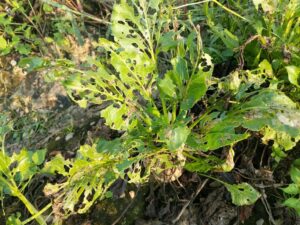 serious damage to a field of sugar beets near East Vineland (see photo at right). This pest can attack peppers, and growers and scouts should check for the presence of heavily damaged leaves near terminal growth on pepper plants. BAW larvae will be found in the area of damage. As yet, no injury to peppers has been reported.
serious damage to a field of sugar beets near East Vineland (see photo at right). This pest can attack peppers, and growers and scouts should check for the presence of heavily damaged leaves near terminal growth on pepper plants. BAW larvae will be found in the area of damage. As yet, no injury to peppers has been reported.
The highest nightly pheromone trap catches of BAW for the week ending 09/15/21 are as follows:
| East Vineland 6 | Folsom 1 |
| Woodstown 2 | Jones Island 1 |
Pumpkins and Winter Squash
Cucurbit downy mildew (CDM) has been found, and should be considered active in all parts of the state on cucumbers and pumpkins. For regional information on this important disease, see the Cucurbit Downy Mildew Forecast webpage: http://cdm.ipmpipe.org/. This forecast has NJ at low risk of further infection as a result of new transport events through Tuesday 9/14. It is advisable that all growers treat preventively for CDM on 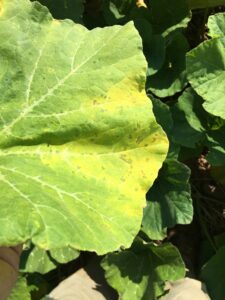
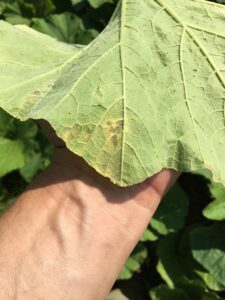 all potential host crops. CDM symptoms on the upper leaf surface include yellow areas that rapidly turn necrotic (photo at far left). Signs of dark sporulation on the lower leaf surface may be found in close association with leaf veins (photo at near left).
all potential host crops. CDM symptoms on the upper leaf surface include yellow areas that rapidly turn necrotic (photo at far left). Signs of dark sporulation on the lower leaf surface may be found in close association with leaf veins (photo at near left).
For a list of effective materials and fungicide rotations, see the Pumpkin/Winter Squash section of the 2020-21 Commercial Veg. Recs.
Recent wet weather has resulted in increased incidence of Plectosporium blight on pumpkins and winter squash. This fungal disease causes stems and petioles to develop dry, white lesions that coalesce, causing stems to become brittle (photo at far right). Fruit may also be affected (photo at near right). Protectant fungicides should be used with EVERY fungicide application. Materials in FRAC grp. 11 may also be of some use against Plectosporium blight. See the Pumpkin/Winter Squash section of the 2020-21 Commercial Veg. Recs. for a list of useful materials.
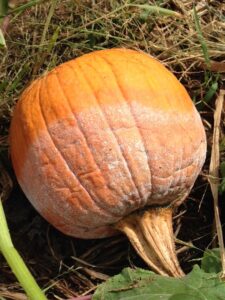 Unfortunately, recent extreme rain events have caused flare-ups of Phytophthora fruit rot (see photo at left), with significant crop loss occurring in a number of fields. There is no effective form of chemical control for this disease at this stage. Growers are now beginning to remove fruit from fields. Avoid harvesting fruit in and near areas showing obvious signs of Phytophthora. Fruit that may appear solid in the field can develop rot while in bins, resulting in more damaged fruit.
Unfortunately, recent extreme rain events have caused flare-ups of Phytophthora fruit rot (see photo at left), with significant crop loss occurring in a number of fields. There is no effective form of chemical control for this disease at this stage. Growers are now beginning to remove fruit from fields. Avoid harvesting fruit in and near areas showing obvious signs of Phytophthora. Fruit that may appear solid in the field can develop rot while in bins, resulting in more damaged fruit.
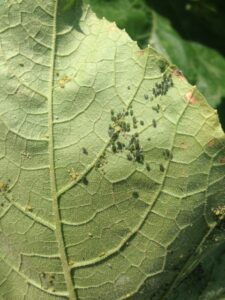 Melon aphid (see photo at left) populations may be present in pumpkin and winter squash fields. This aphid builds to heavy populations
Melon aphid (see photo at left) populations may be present in pumpkin and winter squash fields. This aphid builds to heavy populations 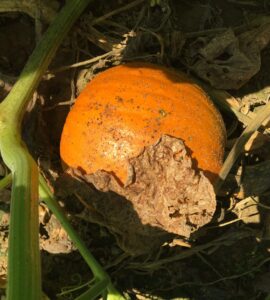 that result in the deposition of sticky droppings on the surface of fruit (see photo at right). If melon aphids appear in more than one sample site in a 10 site sample, consider treating to minimize the appearance of droppings. Insecticides effective at managing this pest are found in the Pumpkin and Winter Squash section of the Commercial Vegetable Production Recommendations.
that result in the deposition of sticky droppings on the surface of fruit (see photo at right). If melon aphids appear in more than one sample site in a 10 site sample, consider treating to minimize the appearance of droppings. Insecticides effective at managing this pest are found in the Pumpkin and Winter Squash section of the Commercial Vegetable Production Recommendations.
Brown marmorated stink bug (BMSB)
BMSB blacklight trap catches have remained low this past week, and no map will appear in this addition.
